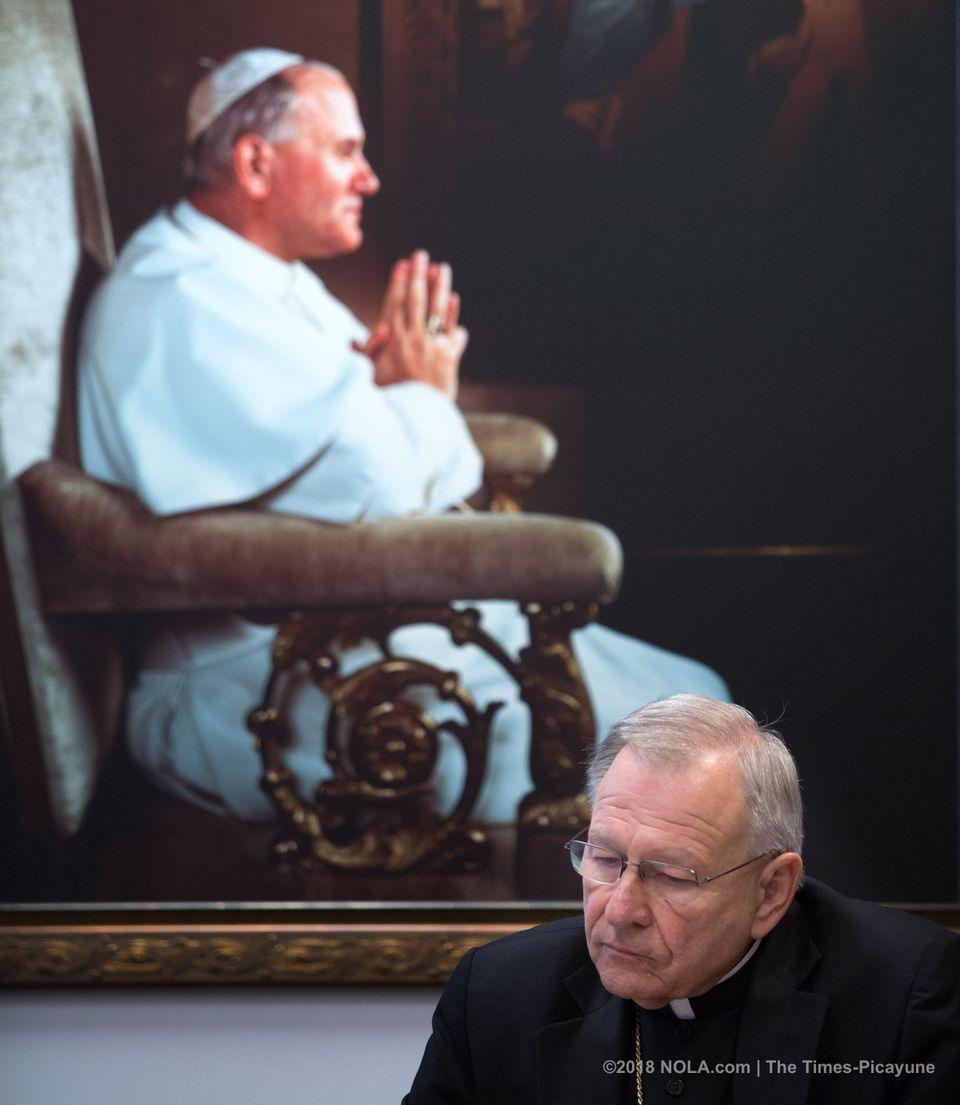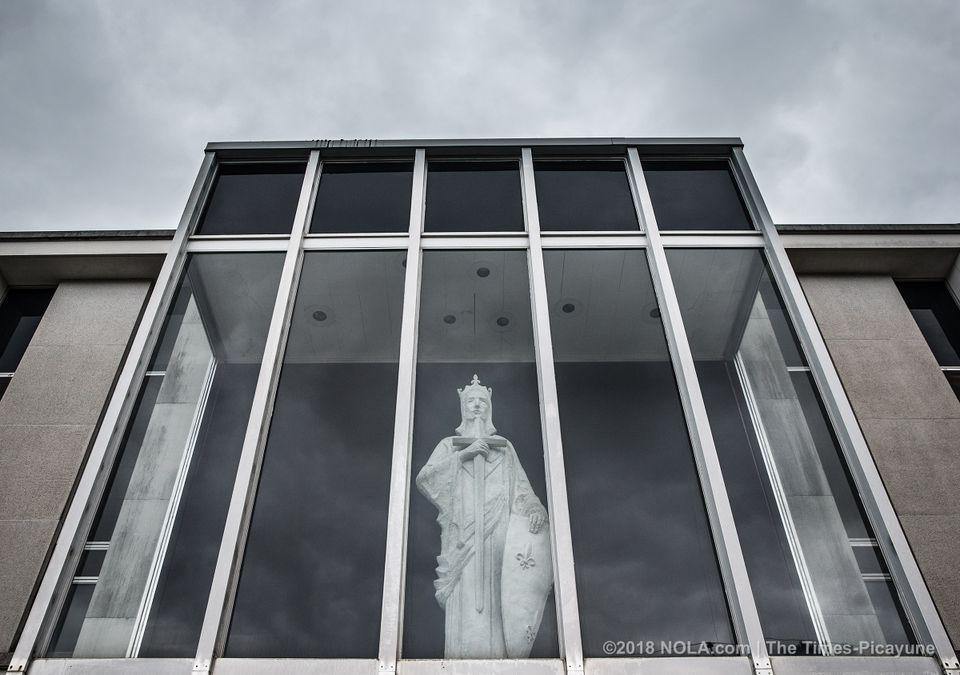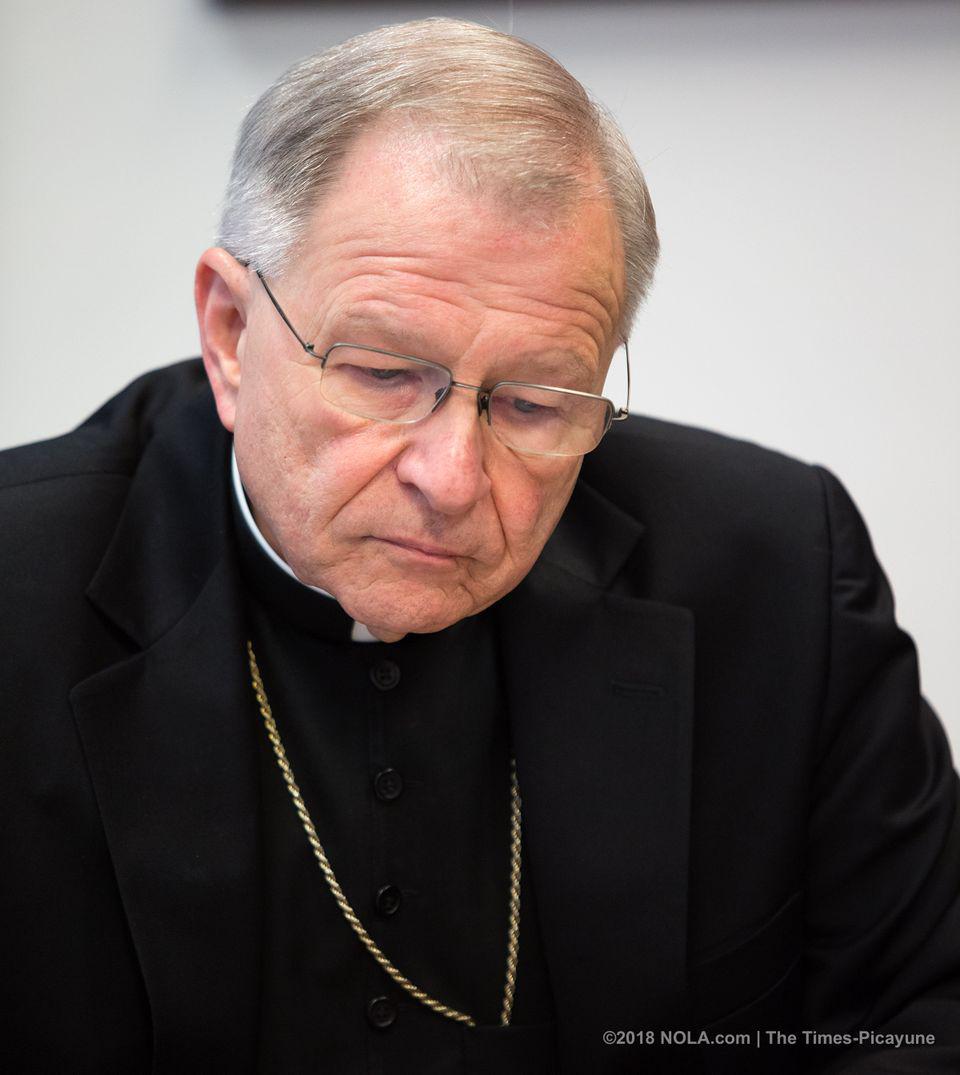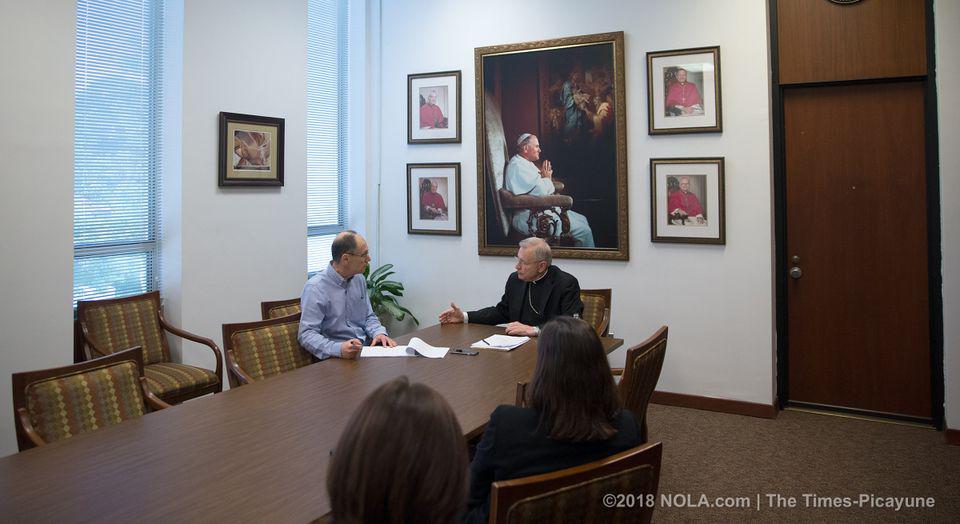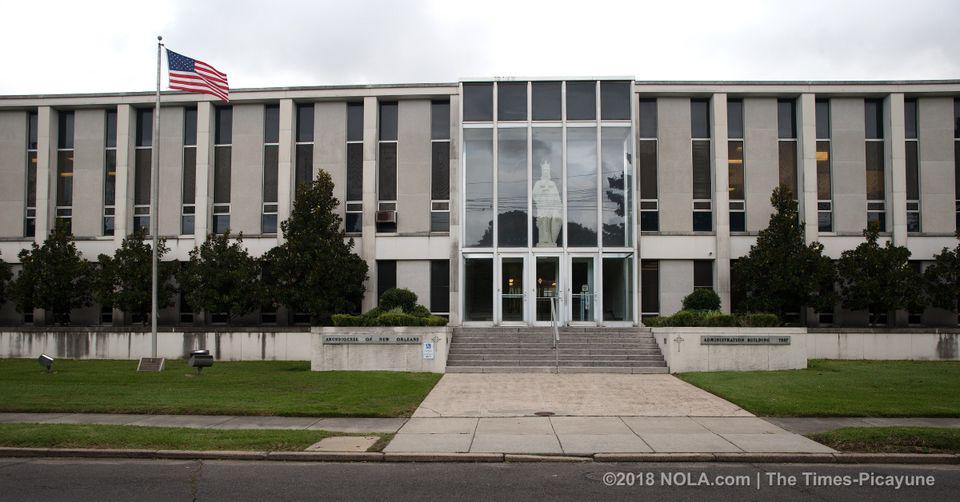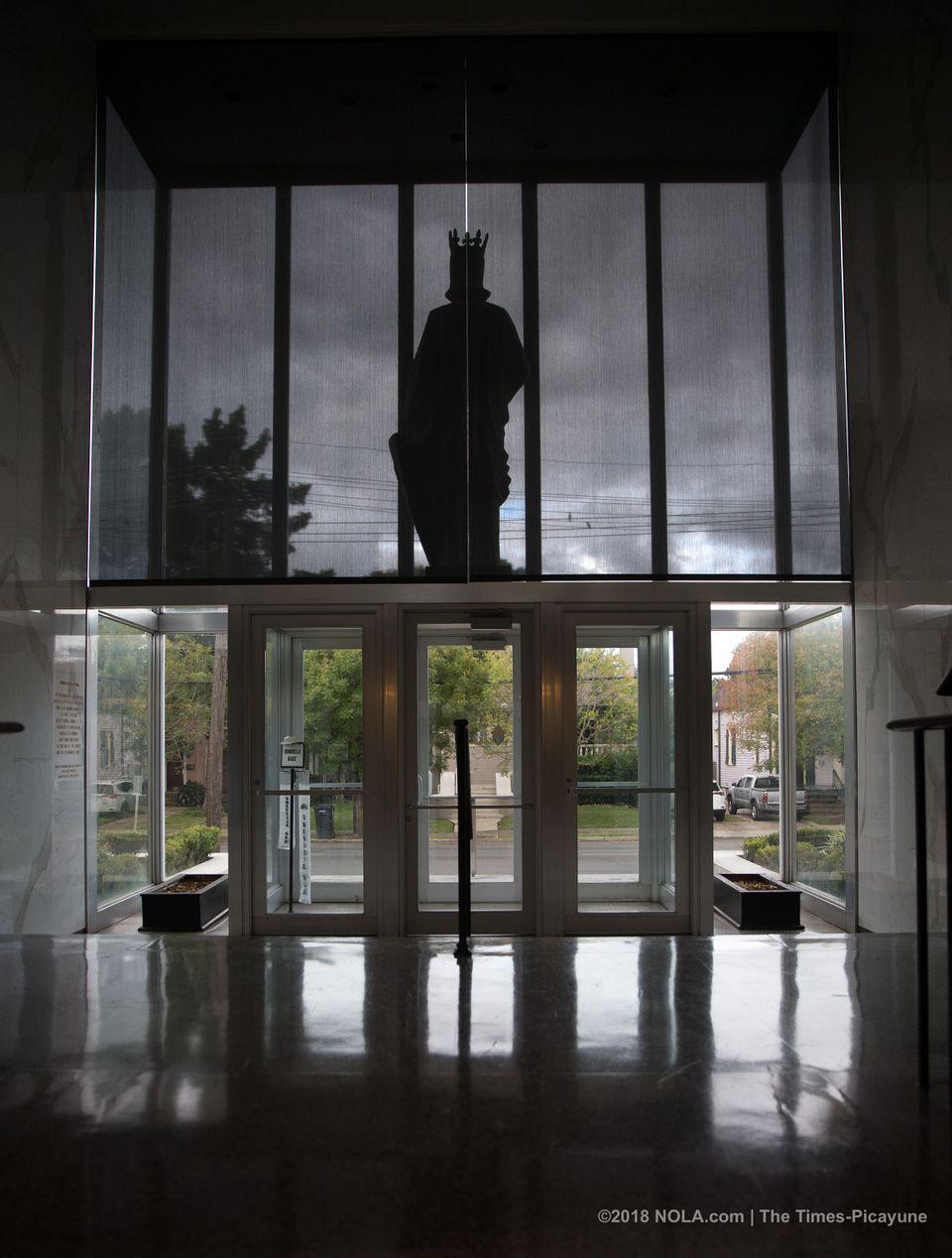|
57 clergy members ‘credibly accused’ of abuse in New Orleans area since 1950, archdiocese says in releasing names
By Kim Chatelain
The Archdiocese of New Orleans on Friday (Nov. 2) released the names of 57 Roman Catholic clergy members “credibly accused” of abusing minors over many decades in southeast Louisiana, answering a clarion call for transparency in a scandal that has rocked the world’s largest Christian church. All of the credibly accused clergy members are either deceased or have been removed from the ministry, Archbishop Gregory Aymond said. The names have been turned over to the New Orleans District Attorney’s Office and will be made available to any other district attorney in the area. The New Orleans DA issued a statement Friday morning saying it is willing to take part in investigations as needed. “For our sins of the past, we ask for your forgiveness and the mercy of God,” Aymond said in a pastoral letter released in conjunction with the list of the accused. “Our sin is public and it calls us as church leaders to repentance in order that our church can experience renewal.” In an interview Friday, Aymond said the names of the accused clergy members will be published on the archdiocese website. If any additional clergy members are deemed credibly accused, their names will be made public and added to the list, he said. The list of accused clergy and the pastoral letter will be made available to church members who attend masses this weekend, either as a printed handout or in the archdiocese newspaper. Aymond said it was decided that the letter should not be read by priests during masses because its mature subject matter might not be suitable for children in attendance. The archbishop said a team of more than 10 legal professionals and archdiocese staff members reviewed the files of 2,432 priests who served in the archdiocese since 1950. Of those, the review identified 57 who were included in the report. Some of the reported offenses occurred as far back as the early part of the 1900s although they were not reported by victims and logged by the archdiocese until the second half of the 20th century, archdiocese officials said. “There has not been a substantiated allegation of sexual abuse of a minor committed in well over a decade by a member of the clergy in ministry in the Archdiocese of New Orleans,” he said. Aymond said the archdiocese has done its best to make the report released Friday "as accurate and complete as possible. He invited those who wish to raise questions “about someone not on the list” to come forward. Eight of those on the list are were assigned to Hope Haven, a church-run orphanage in Marrero. The archdiocese said it learned of allegations against the eight between 2006 and 2011. All clergy members on the list released Friday were deemed to be “credibly accused” by the archdiocese. Since 2000, that determination has been made through a multi-step process. Any priest accused of abuse is immediately suspended from all church ministries while the archdiocese, and in some cases police, investigate. The results are turned over to a lay review board made up primarily of mental health professionals and chaired by a psychiatrist. If the review board determines that the complaint is credible, a recommendation is made to the bishop and the bishop can then immediately defrock the cleric and the parishes in which he worked are notified, the archdiocese said. For cases that were reported before the review board was established a decade and a half ago, the way in which the cases were investigated and declared credible varied, Aymond said. The process was formalized in 2002. In publicly identifying local offenders the day after All Saints Day, Aymond followed the lead of about 50 dioceses in the U.S. who have published lists of accused priests in the wake of an explosive Pennsylvania grand jury report in August that named more than 300 priests credibly accused of sexually abusing more than 1,000 child victims over several decades in that state. That report reignited the national, decades old scandal over clergy abuse and the church’s coverup, which had its origins in south Louisiana in the 1980s. "Priests were raping little boys and girls," the Pennsylvania grand jury wrote in its report, "and the men of God who were responsible for them not only did nothing; they hid it all. For decades." Aymond announced last month that he would release the names “sooner rather than later” as he and other church leaders scrambled to quell outrage among the faithful. Many bishops have said identifying the offending clergy members is an important step toward full transparency, accountability and renewal of the church, which has approximately 1.3 billion followers worldwide. “As church leaders, in many ways, we have lost your trust and I am keenly aware of that,” Aymond said during a Mass St. Louis Cathedral in late August. “We want to regain that trust. And we know that it will take a long time." Prosecutors in jurisdictions across the country have in recent months launched investigations into the church’s conduct, including an inquiry by the U.S. Department of Justice in Pennsylvania. As part of that investigation, the department has asked all dioceses in the U.S. to preserve records of abuse. The New Orleans archdiocese last week said it is keeping its records and would cooperate with any investigation, although it said it had not yet received a direct request from the Justice Department. Meanwhile, New Orleans area district attorneys and state officials, including Attorney General Jeff Landry and Gov. John Bel Edwards, have not announced any investigations into clergy abuse. Clergy abuse in the Catholic Church made headlines decades ago when New Orleans investigative reporter and author Jason Berry documented the wrongdoings of the Rev. Gilbert Gauthe, a priest in the Diocese of Lafayette. In 1985, Gauthe was convicted of sexually abusing as many as 39 young children. Other revelations surfaced over the years, setting the stage for an explosive 2002 report by the Boston Globe that revealed widespread abuse and coverup in Boston, leading to the criminal prosecutions of five Roman Catholic priests for sexually abusing minors. That report prompted the U.S. Conference of Bishops to create the “Charter for the Protection of Children and Young People.” The charter, which has been updated three times since 2002, mandates that all dioceses in the U.S. establish safeguards to protect children who are involved in the Catholic Church. Aymond and other Catholic leaders have said that while the church hierarchy has sinned in covering up the actions of pedophile priests and in some cases simply transferring them to other ministries after they were found to have abused children, the number of offenses drastically declined since the charter was put in place. Still, the constant barrage of news reports detailing the church’s actions are prompting victims who were abused by clergy years ago to step forward, at times resulting in high dollar settlements paid out by the church. Church critics have said even though the number of clergy abuse incidents may be on the decline, the fact that the church has continued to shield past offenders from public disclosure is fueling anger. Victims, their families, the news media and others have said the biggest step toward healing is full transparency, an opening of the records to name all the priests who were found to be credibly accused of child sex abuse. Tim Lennon, president of the board of directors for the Survivors Network of those Abused by Priest, said the release of names by dioceses across the country is a step in the right direction but does not completely absolve the church. “One one hand, it’s great for survivors,” said Lennon, who says he was abused by a clergy member as a child. “Most survivors are looking for acknowledgement for what they suffered. On the other hand, why did it take all of the high profile exposures before you (the church) to do the right thing.” Aymond acknowledged he prayed long and hard over whether to release the names before deciding it is the right thing to do. The surviving clergy members on the list were notified that their names were going to be released. Efforts were made to reach family members of deceased clergy members on the list, but some efforts were not successful. “Some will be surprised to see the name of a priest who served in your parish or who you personally knew very well,” Aymond said in his letter to local Catholics. “As you experience this disappointment, I raise you to the Lord and ask him to give you comfort and his peace.” The archbishop said he had hesitation in releasing the names because he wanted to make sure the list was complete and accurate. He said he was also concerned about releasing the names of deceased priests who are no longer around to defend themselves. “I brought this to prayer and it became very clear to me that this was the right thing to do,” he said. “We have to be open, honest and transparent. It’s a sad day, but my sadness is for the victims and survivors who are still going on with their daily lives and experiencing a lot of pain. But I also have hope that this will help them heal.” Contact: kchatelain@nola.com
|
.
Any original material on these pages is copyright © BishopAccountability.org 2004. Reproduce freely with attribution.
